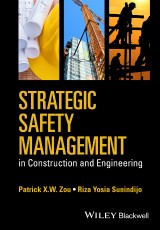Details

Strategic Safety Management in Construction and Engineering
1. Aufl.
|
85,99 € |
|
| Verlag: | Wiley-Blackwell |
| Format: | |
| Veröffentl.: | 26.03.2015 |
| ISBN/EAN: | 9781118839348 |
| Sprache: | englisch |
| Anzahl Seiten: | 256 |
DRM-geschütztes eBook, Sie benötigen z.B. Adobe Digital Editions und eine Adobe ID zum Lesen.
Beschreibungen
<p>Although the construction and engineering sector makes important contributions to the economic, social, and environmental objectives of a nation, it has a notorious reputation for being an unsafe industry in which to work. Despite the fact that safety performance in the industry has improved, injuries and fatalities still occur frequently. To address this, the industry needs to evolve further by integrating safety into all decision making processes. <br /><b><i><br />Strategic Safety Management in Construction and Engineering</i> </b>takes a broad view of safety from a strategic decision making and management perspective with a particular focus on the need to balance and integrate ‘science’ and ‘art’ when implementing safety management. The principles covered here include the economics of safety, safety climate and culture, skills for safety, safety training and learning, safety in design, risk management, building information modelling, and safety research methods and the research-practice nexus. They are integrated into a strategic safety management framework which comprises strategy development, implementation, and evaluation. Practical techniques are included to apply the principles in the context of the construction and engineering industry and projects. Case studies are also provided to demonstrate the localised context and applications of the principles and techniques in practice.</p>
<p>Foreword vii</p> <p>Acknowledgements ix</p> <p><b>1 Safety Management in Construction and Engineering: An Introduction 1</b></p> <p>The importance of the industry 1</p> <p>Characteristics of the construction and engineering sector 2</p> <p>Why a book on strategic safety management? 6</p> <p>Historical development and current trends in construction safety management 6</p> <p>The book’s contents 10</p> <p>References 14</p> <p><b>2 Economics of Safety 17</b></p> <p>Costs of construction accidents 18</p> <p>Benefits of investment in safety 29</p> <p>Return on investment in safety management 33</p> <p>A case study on return on investment in safety risk management 35</p> <p>Optimisation of investment in safety risk management 40</p> <p>Evaluation of investment in safety risk management 44</p> <p>Conclusions 49</p> <p>References 49</p> <p><b>3 Safety Climate and Culture 53</b></p> <p>Safety climate 54</p> <p>Safety culture 58</p> <p>Safety culture maturity measurement criteria and frameworks 62</p> <p>Safety culture maturity measurement instrument 65</p> <p>Case studies 69</p> <p>Utility of safety culture 80</p> <p>Conclusions 81</p> <p>References 82</p> <p><b>4 Skills for Safety 86</b></p> <p>An overview of the skill set 86</p> <p>Conceptual skill 92</p> <p>Human skill 95</p> <p>Political skill 99</p> <p>Technical skills 103</p> <p>Skill development model 106</p> <p>Skill development strategies 111</p> <p>Conclusions 117</p> <p>References 118</p> <p><b>5 Safety Training and Learning 123</b></p> <p>Training and learning defined 124</p> <p>Approaches to learning: pedagogy and andragogy 124</p> <p>Safety learning in construction and engineering 128</p> <p>Techniques for evaluating safety training and learning 139</p> <p>Case study 142</p> <p>Conclusions 148</p> <p>References 149</p> <p><b>6 Safety in Design, Risk Management and BIM 152</b></p> <p>What is safety in design? 152</p> <p>Why is it necessary to implement safety in design? 155</p> <p>Safety in design policies and guidelines 156</p> <p>Safety risk management 160</p> <p>Current issues and possible solutions 170</p> <p>Case studies 172</p> <p>Building information modelling (BIM) for safety in design 175</p> <p>Conclusions 177</p> <p>References 177</p> <p><b>7 Research Methodology and Research–Practice Nexus 180</b></p> <p>A typical research process 181</p> <p>Research methodologies 183</p> <p>Current state of play on safety research methodologies 193</p> <p>Social desirability bias in research design 195</p> <p>Why and how social desirability bias happens 197</p> <p>Techniques for minimising social desirability bias in safety research 200</p> <p>Research-practice nexus 203</p> <p>Discussions 207</p> <p>Assessing the relevance of research outcomes in practical application 208</p> <p>Conclusions 208</p> <p>References 210</p> <p><b>8 Strategic Safety Management 214</b></p> <p>A strategic safety management framework 215</p> <p>Developing safety management strategies 216</p> <p>Implementing safety management strategies 220</p> <p>Evaluating safety management strategies 224</p> <p>Case study 225</p> <p>Conclusions 230</p> <p>References 231</p> <p>Bibliography 234</p> <p>Index 237</p>
<p><b>Patrick Xiao Wei Zou</b> is Professor and Research Leader of Construction Engineering and Management at Swinburne University of Technology, Australia. With a PhD in Civil Engineering from the University of New South Wales (UNSW), Australia, he has held a professorship at the University of Canberra and associate professorship at UNSW, and visiting academic appointments at several universities in the UK, USA, Singapore and China. Dr Zou is an award winning researcher and teacher in the fields of safety management, risk management, and sustainable building and construction systems. Prior to entering to academia he worked as construction engineer. </p> <p><b>Riza Yosia Sunindijo</b> is a Lecturer in Construction Management in the Faculty of the Built Environment, at the University of New South Wales. He has also worked as a project engineer, project manager, and sustainability champion for a range of multi-national construction and project management organisations</p> <p> </p>
<p>Although the construction and engineering sector makes important contributions to the economic, social, and environmental objectives of a nation, it has a notorious reputation for being an unsafe industry in which to work. Despite the fact that safety performance in the industry has improved, injuries and fatalities still occur frequently. To address this, the industry needs to evolve further by integrating safety into all decision making processes. <br /><b><i><br />Strategic Safety Management in Construction and Engineering</i> </b>takes a broad view of safety from a strategic decision making and management perspective with a particular focus on the need to balance and integrate ‘science’ and ‘art’ when implementing safety management. The principles covered here include the economics of safety, safety climate and culture, skills for safety, safety training and learning, safety in design, risk management, building information modelling, and safety research methods and the research-practice nexus. They are integrated into a strategic safety management framework which comprises strategy development, implementation, and evaluation. Practical techniques are included to apply the principles in the context of the construction and engineering industry and projects. Case studies are also provided to demonstrate the localised context and applications of the principles and techniques in practice.</p>

















